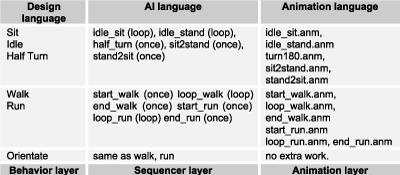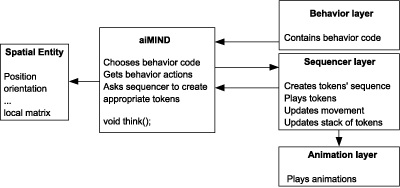|
|||||||||
Sequencing Animations Intelligentlyby Stéphane Assadourian One of the main problems to tackle for Artificial Intelligence (AI) in 3D first person shooters/sneakers is that non-player characters (NPCs) are constantly taking actions. These creatures should show flexibility and consistency in their general activity, and the ability to react to decisions based on the changing environment. Whenever a change of action is required, it causes a change of animation and therefore the possibility of a failure to achieve a believable behaviour. We will take the common example of a patrolling NPC that can go into a sitting idle state. Developers simply rely on motion blending to handle transitions. The purpose here is to understand why, where blending fails, sequencing works well. Transition versus Sequence
Behaviour Execution
You must know all the actions the creature can perform and how to play the animations (eg once, looped). They must not be too long because you are going to de-synchronize decision and action by letting every action terminate. Delaying the most current behaviour has a price, and you would end up completely de-synchronized if your animations were too long. Cutting an action down to smaller ones (start/loop/end) allows flexibility. AI System Layout
There are two main advantages to adopting such a layout:
The behaviour asks the mind for high-level actions. The mind then asks the sequencer to assess the current one. The sequencer breaks this action into tokens and then asks the animation layer to play the sequence it has come up with, until it ends. De-synchronize Decision and Action In our example, the creature sits in idle state and suddenly decides it needs to move to a patrol point. Table 3 shows the contents of the sequencer when a behaviour switch occurs.
The animation system is playing an idle_sit animation, which is looped. The behaviour suddenly wants a movement action to be performed. As the sequencer receives the order, it finishes playing idle_sit, then inserts a sit to stand animation immediately after it. Such a sit to stand transition done purely by blending would clearly look strange. Conclusion Playing animations with fluidity is one very important key to believable AI, and sequencing them is an invaluable addition. Please contact: |
|||||||||






